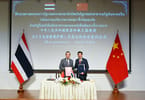A study conducted by the American Society for Microbiology and published in the Nature science journal revealed that 377 strains of bacteria may have survived the sterilization process that the NASA Curiosity rover endured before it was launched in an attempt to avoid contaminating the red planet.
The NASA Curiosity rover that was thought to bring only cameras, sensors, and scientific equipment when it traveled to Mars in August 2012 may have brought along dozens of species of bacteria that originated on Earth, according to a new study.
It was less of a surprise for scientists that the bacteria survived the cleaning process than the revelation about the conditions they went through. The microbes in question endured near-freezing temperatures and intense damage caused by ultra-C radiation, thought to be the most harmful type of radiation.
“Although studies are constantly expanding our knowledge about life in extreme environments, it is still unclear whether organisms from Earth can survive and grow in a Martian environment where there is intense radiation, high oxidation potential, extreme desiccation, and limited nutrients,” microbiologist Stephanie Smith of the University of Idaho in Moscow and lead author of the study wrote in the study’s abstract.
“Knowing if microorganisms survive in conditions simulating those on the Martian surface is paramount to addressing whether these microorganisms could pose a risk to future challenging planetary protection missions.”
Whether the bacteria spread to the Mars surface is unknown, although the very possibility has already made scientists concerned about unnaturally spreading life from earth to Mars.
There is already a United Nations Outer Space Treaty that aims to regulate how the increasingly advanced space programs from the international community explore the unknown. The parameters were first agreed upon in 1966 and they include, among others, the stipulation that “States shall be liable for damage caused by their space objects; and shall avoid harmful contamination of space and celestial bodies.”
The limits vary depending on where the spacecraft lands. Mars, Europa, and other bodies that could potentially nurture life have a relatively strict standard of 300 bacterial spores per square meter. The goal is to keep the odds of contamination Mars (and others) at less than 1 in 10,000.
“Up to 300,000 spores are allowed on the exposed surfaces of the landed spacecraft. That many spores would fit on the head of a large pin,” said Laura Newlin, an engineer at NASA’s Jet Propulsion Laboratory in California. “Currently our total spore count on the surface…is comfortably under 200,000, so we’re below the allowable level.”
The announcement comes at a time when another team of researchers published an unrelated study revealing that methanogens, the oldest organisms on earth, could be the perfect candidate to foster Martian life. The University of Arkansas Fayetteville study determined that, because methanogens are non-photosynthetic and capable of living without oxygen, they are capable of living underground on Mars.
“The surface temperature of Mars varies widely, often ranging between minus 90 degrees Celsius and 27 degrees Celsius over one Martian day,” Rebecca Mickol, a doctoral student of space and planetary sciences, told Science Daily. “If any life were to exist on Mars right now, it would have to at least survive that temperature range. The survival of these two methanogen species, exposed to long-term freeze thaw cycles, suggests methanogens could potentially inhabit the future of Mars.”
WHAT TO TAKE AWAY FROM THIS ARTICLE:
- “Although studies are constantly expanding our knowledge about life in extreme environments, it is still unclear whether organisms from Earth can survive and grow in a Martian environment where there is intense radiation, high oxidation potential, extreme desiccation, and limited nutrients,” microbiologist Stephanie Smith of the University of Idaho in Moscow and lead author of the study wrote in the study's abstract.
- A study conducted by the American Society for Microbiology and published in the Nature science journal revealed that 377 strains of bacteria may have survived the sterilization process that the NASA Curiosity rover endured before it was launched in an attempt to avoid contaminating the red planet.
- The NASA Curiosity rover that was thought to bring only cameras, sensors, and scientific equipment when it traveled to Mars in August 2012 may have brought along dozens of species of bacteria that originated on Earth, according to a new study.






















